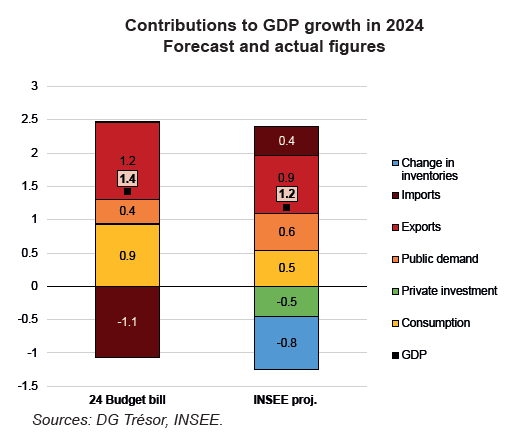Review of the French Government’s Economic Forecasts for 2024
Amid the post-COVID return to economic normalcy in the summer of 2023, in drafting the 2024 Budget Bill the government projected that GDP growth would bounce back to 1.4%. A series of new external shocks (deterioration in the international environment, rising interest rates and uncertainty) ultimately penalised 2024 growth recovery, which was weaker than expected overall (+1.2%).
When drawing up the macroeconomic scenario for the 2024 Budget Bill presented in September 2023, we expected that 2024 would see a gradual cushioning of the shocks that had hit the economy. As such, expectations focused on an upswing in growth bolstered by a ramp-up in household consumption. The main contingency identified in the forecast concerned the pace and extent to which monetary tightening would affect both real GDP and the financial sphere.
GDP growth in 2024 (up 1.2% according to INSEE’s annual accounts published in May 2025) fell short of the 2024 Budget Bill forecast of 1.4% and broke down differently than expected due to a fresh wave of shocks that were largely unforeseeable in autumn 2023.
The deterioration in the international environment, particularly the second consecutive year of recession in Germany, curbed French exports. Meanwhile, uncertainties at both international (tension in the Middle East in particular) and national level (dissolution of the French National Assembly) put a drag on investment. The catch-up following productivity losses since the COVID-19 pandemic has been faster than anticipated, leading to a more pronounced slowdown in employment. Lastly, the faster-than-anticipated drop in inflation failed to boost consumption due to the less favourable breakdown of purchasing power gains.
Nevertheless, some of these negative shocks were absorbed by a fall in imports, partly replaced by inventory rundowns, and by rising public demand, mainly concerning local authorities and healthcare spending. Despite the adverse impact on the government deficit, increased public demand naturally buoyed up economic activity.
